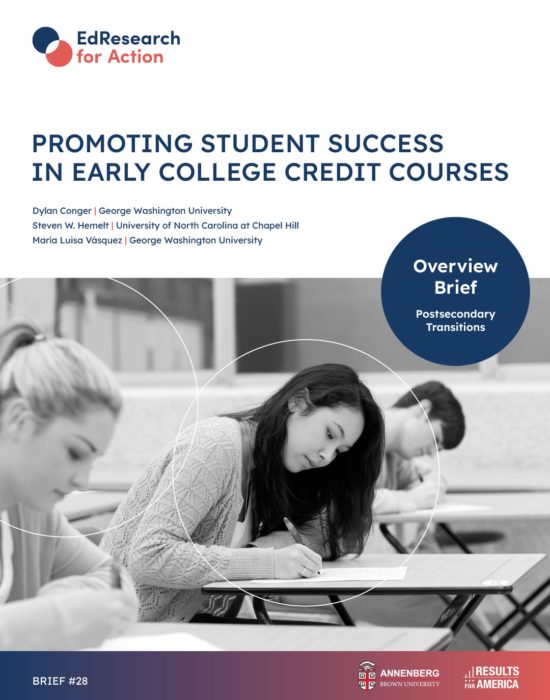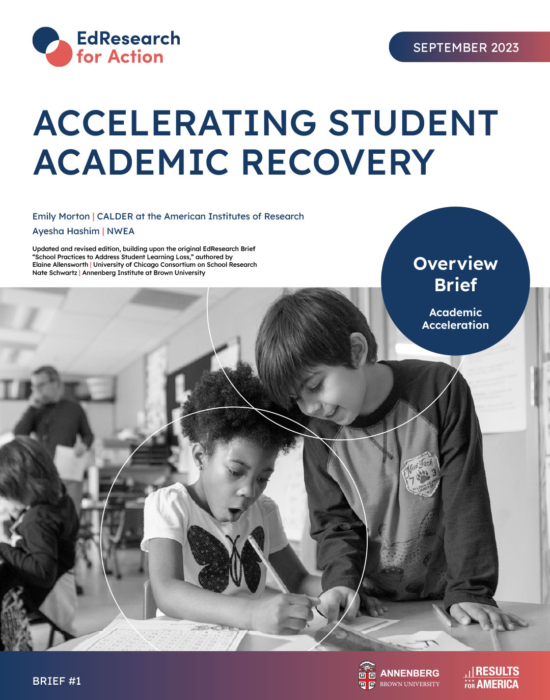DESIGN PRINCIPLES FOR EFFECTIVE ONLINE CREDIT RECOVERY
Carolyn J. Heinrich | Vanderbilt University
June 2022 | Brief No. 4
Design Principle Series
At A Glance
INSTRUCTIONAL DESIGN
BLENDED LEARNING
- Students are most likely to benefit from online credit recovery when it blends online instruction with face-to-face time, rather than being conducted fully online.
CLASS SIZE & GROUPING
- Grouping students into smaller, subject-specific classes allows for stronger instructional support.
PROGRESS MONITORING
- Course monitoring data and student check-ins help instructors develop personalized learning supports for students, which improves their likelihood of successful course completion
STUDENTS
STUDENT SELECTION
- Carefully targeting which students are offered the opportunity to repeat courses online may increase the chances that students will learn the missed material.
PERSONNEL
STUDENT SUPPORT
- Instructors who are trained to deliver both academic and nonacademic support are better positioned to help students succeed.
PROFESSIONAL DEVELOPMENT
- Instructors often need professional development in using online credit recovery technology and accommodating special student learning needs in an online environment
TECHNOLOGY
VENDOR SELECTION
- Selecting a vendor and negotiating a contract that supports blended learning and individualized curriculum adaptation increases the likelihood that students will learn the material they missed.
TECHNICAL CAPACITY
- Investment in sufficient Internet connectivity, devices, and technical support reduces disruptions and increases the quality of the student experience.
The Evidence Base
Schools and districts are increasingly turning to online credit recovery as a strategy to help students make up coursework missed during COVID-19.
- Nearly 70 percent of high schools offer credit recovery programs, which allow students to recover course credits by repeating a previously failed course.
- On average, eight percent of high school students enroll in at least one credit recovery course. In one in 10 schools, 20 percent or more of students take at least one course through credit recovery.
- Online credit recovery is a version of credit recovery in which course content is delivered online, usually through a vendor rather than being developed by district staff.
- Students typically work through the online course content at their own pace, often in lab- style classrooms with other students who may be completing different courses.
- One advantage of online credit recovery is “anytime, anywhere” access to course content. Online credit recovery may also allow students to complete courses in less time if they are permitted to pre-test out of portions of the course.
- Even before the pandemic, online credit recovery programs were used in all 50 states.
- After substantial increases in course failures during the pandemic, more high schools turned to online credit recovery as a strategy to give students opportunities to graduate on time.
- One widely used online credit recovery vendor added more than 500 additional public school districts as clients during the first year of the pandemic.
Vendor-provided online credit recovery programs often do not accommodate the learning needs of students who read below grade level or require special academic supports.
- Student course failures during the pandemic often occurred in virtually delivered courses. Interviews with school staff have raised concerns about whether additional online coursework will be a successful strategy for getting students back on track.
- Students whose reading levels are lower than what is required for accessing online course content often struggle to complete their courses.
- Teachers have identified mismatch between student reading levels and the reading levels required for online course-taking as one of the biggest barriers to student learning in online credit recovery.
- Students reading below grade level spend more time idle in online courses and are less likely to engage with instructional videos and successfully complete quizzes and tests
- Teachers have identified mismatch between student reading levels and the reading levels required for online course-taking as one of the biggest barriers to student learning in online credit recovery.
- Students who lack self-regulation skills, are English learners (ELs), or need special accommodations for learning disabilities may not be well-served by online credit recovery.
- Pacing is typically the only adjustment teachers and students can make.
- Instructors in online credit recovery classrooms rarely have access to student individual education plans (IEPs) or support from special education teachers.
- Language accommodations for ELs are frequently insufficient. Vendors may provide written translation, but not all students can read academic text in their native language.
- Strong supplemental learning supports and high levels of face-to-face teacher interactions may help counteract some of these limitations, but these are resource-intensive strategies that are seldom used in online credit recovery classrooms
Online credit recovery often results in less learning and lower earnings than face-to-face credit recovery, even if students regain course credits.
- Multiple studies show that compared to students in face-to-face credit recovery, students in online credit recovery may regain course credits but have lower test scores.
- In the only published randomized trial of online versus face-to-face credit recovery for Algebra I, more than two-thirds of students across conditions regained credit. However, students in the online program were 12 percentage points less likely to regain credit than those who repeated the course traditionally. Students in the online course also had significantly lower scores on end-of-course tests.
- A study of 7 million student sessions in online courses (taken primarily for credit recovery) found “mostly negative associations between online course-taking and math and reading scores,” suggesting that some students may even be set back in their learning by taking online courses. Some upperclassmen earned more credits and had higher grade point averages relative to students in face-to-face credit recovery courses when the online course grades replaced the failed credits, but these same benefits were not realized by underclassmen in online credit recovery.
- A study of the labor market outcomes of students who used online credit recovery in high school found they had lower earnings over time than those who repeated courses the traditional way.
- The lower earnings appeared to be associated with lower skills acquired by those recovering course credits online, which were reflected in lower wages received on the job or a slower rate of increase in earnings over time compared to those repeating courses in traditional classroom settings
Design Principles
INSTRUCTIONAL DESIGN
BLENDED LEARNING | Students are most likely to benefit from online credit recovery when it blends online instruction with face-to-face time, rather than being conducted fully online
- Studies have shown that a blended component enhances online instruction.
- In the experimental (Algebra I) study, students in online credit recovery who had a math teacher in the classroom providing instructional support performed as well as students in face-to-face classes.
- Face-to-face time is particularly helpful for students who need support for learning course content and adjustments to the online learning format beyond pacing, including for Els when audio translation in the online program is not available.
- Making one-to-one, synchronous instructional supports available outside the regular school day can help to expand equity in access to online credit recovery.
CLASS SIZE AND GROUPING | Grouping students into smaller, subject-specific classes allows for stronger instructional support
- Providing online credit recovery in large, lab-style classrooms may reduce costs compared to traditional classroom environments, but this may come at the price of reduced student learning.
- Students are more likely to use technology appropriately when instructors are actively interacting with them in the classroom.
- In the absence of face-to-face support for learning subject matter, students are more likely to guess or Google-search their way through online course tests.
- Teachers who focus on playing an engaged, instructional role—e.g., proactively checking in with students on their course activities and offering face-to-face learning support— rather than simply managing access to the course software may get better academic results from their students.
- Grouping students in classrooms by the course they are repeating and assigning instructors with subject-area expertise increases opportunities for supporting student learning.
PROGRESS MONITORING | Course monitoring data and student check-ins help instructors develop personalized learning supports for students, which improves their likelihood of successful course completion.
- Data collected on student activities completed online and regular student check-ins to review progress with an instructor can be helpful in tailoring supports to students’ individual learning needs.
- Online credit recovery systems often collect data on student interactions with the system—e.g., active time, idle time, activities completed, assessment scores—that teachers can use to develop benchmarks for progress or strategies for identifying and reassigning students who are not being well-served by technology-based instruction.
- Observations of credit recovery classrooms showed that teachers can also use these data to motivate student engagement through incentives for progress toward course completion goals.
- Monitoring to see what students have open on their screens is insufficient for supporting student engagement and learning.
- Research finds that students most in need of additional assistance in their online courses may be the least likely to ask for help
STUDENTS
STUDENT SELECTION | Carefully targeting which students are offered the opportunity to repeat courses online may increase the chances that students will learn the missed material.
- Research has been clearer about which students struggle with online credit recovery than which students it serves well.
- The available evidence suggests that students will be most successful with online credit recovery if they are in their junior or senior high school year and therefore more focused on the goal of graduation, have limited or no need for special academic assistance, and only need to make up one or two courses vs. students who have fallen far behind grade level in their progress toward graduation.
- Limiting the number of courses a student recovers online at one time may also support student progression. A study of one school district found that students’ completion of course activities and modules slowed when they were trying to make progress in multiple online courses.
PERSONNEL
STUDENT SUPPORT | Instructors who are trained to deliver both academic and non-academic support are better positioned to help students succeed.
- Observational studies find that students often lack consistent, constructive interactions with teachers, particularly those capable of providing course content support.
- While relying on paraprofessionals and substitute teachers may reduce instructional costs, they are less likely to have the training for providing technology support or content learning assistance to students.
- Research suggests that students may also need teachers to fill non-instructional roles such as counselor or confidant to help them gain confidence and overcome socioemotional barriers to academic success, particularly when they have fallen far behind in accumulating course credits due to personal challenges.
- With students working solo toward individual educational goals in the online credit recovery setting, instructor encouragement and socioemotional support can be key to helping them stay engaged.
PROFESSIONAL DEVELOPMENT | Instructors often need professional development in using online credit recovery technology and accommodating special student learning needs in an online environment.
- Instructors in credit recovery classrooms need ongoing training and campus-based technical supports to manage online credit recovery tasks such as setting student access, electronically monitoring progress, unlocking content, and so on, that are beyond what most will have acquired in traditional classroom settings.
- Instructors may need additional resources and supports to develop materials that can supplement and adapt the online course content for students who require extra assistance or accommodations for learning.
- Instructors may need to rely on EL and special education teachers (or supplemental materials developed by them) to deliver instruction face-to-face when online program supports are inadequate.
TECHNOLOGY
VENDOR SELECTION | Selecting a vendor and negotiating a contract that supports blended learning and individualized curriculum adaptation increases the likelihood that students will learn the material they missed.
- Vendors differ in how much they emphasize and support blended learning, a key design principle for effective online credit recovery programs.
- Research and media reports find that schools may be offered varying contract terms and supports, even from the same vendor.
- Among the contract provisions that school districts can negotiate with a vendor, teacher training for delivering blended learning and using system data for monitoring and personalizing assistance is one of the most critical for supporting student success
TECHNICAL CAPACITY | Investment in sufficient Internet connectivity, devices, and technical support reduces disruptions and increases the quality of the student experience.
- A RAND Education study found that most schools using online educational tools lack the time, resources, training, and other capacities critical for implementing high-quality online instruction and personalized learning.
- High-speed Internet connectivity, adequate devices, and school-based technology assistance are key to minimizing technical disruptions to online learning that can set back student progress and contribute to student disengagement
This EdResearch for Action Project brief is a collaboration among:



Funding for this research was provided by the Bill & Melinda Gates Foundation. The findings and conclusions contained within are those of the authors and do not necessarily reflect positions or policies of the foundation.






